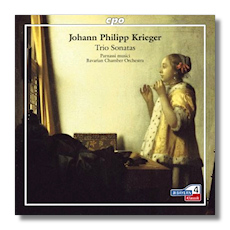
The Internet's Premier Classical Music Source
Related Links
- Latest Reviews
- More Reviews
-
By Composer
-
Collections
DVD & Blu-ray
Books
Concert Reviews
Articles/Interviews
Software
Audio
Search Amazon
Recommended Links
Site News
 CD Review
CD Review
Johann Philipp Krieger

XII Sonate à due Violini (1688)
- Sonata Prima in D minor
- Sonata Seconda in E minor
- Sonata Terza in F Major
- Sonata Quarta in G Major
- Sonata Quinta in A minor
- Sonata Sesta in B Flat Major
- Sonata Settima in B minor
- Sonata Ottava in C Major
- Sonata Nona in G minor
- Sonata Decima in D Major
- Sonata Ondecima in A Major
- Sonata Duodecima in C minor
Parnassi musici
CPO 777294-2 DDD 67:27
This CD is a major addition to the limited discography of German Baroque composer Johann Philipp Krieger, who was born in Nürnberg in 1649 and died in Weisenfels in 1725. This puts him more than a generation before Johann Sebastian Bach (1685-1750). Despite Krieger's apparent readiness to travel – he spent several formative years in Copenhagen, and journeyed to Italy later in the 1670s – I've come across no evidence that he and Bach ever became personally acquainted.
Like Bach, Krieger made contributions to many genres. There are operas (he wrote 18 of them, of which none survive today), many cantatas (similarly lost to posterity, with a few exceptions), and instrumental music, including works for organ. In addition to the trio sonatas recorded here, there is a set of sonatas for violin, viola da gamba, and basso continuo, published in 1693.
Martin Lubenow's booklet notes are not quite precise about this, but it looks as if Krieger himself specified the use of an organ to serve as the basso continuo in Sonatas #1, 2, and 9, and the harpsichord in the rest. (Lubenow prepared an edition of these sonatas for Musiche Varie.) On the other hand, Parnassi musici appears to have made the decision to add viola da gamba (plus or minus lute) to the basso continuo in all of the sonatas, with the exception of Sonata #3. Sonically, it was a happy decision. The ear immediately responds to the richness of the basso continuo in the very first sonata, in which the viola da gamba, the lute, and the organ blend together most attractively, providing a complementary setting for the two violins.
Each sonata requires about five minutes to play. The sonatas are sectional, but they are not divided into clearly distinguishable movements. Krieger's travels are reflected in these trio sonatas. Although the primary style is German, one can detect hints of an Italian influence as well.
The members of Parnassi musici are Margaret MacDuffie and Matthias Fischer (violins), Matthias Müller (viola da gamba), Hubert Hoffmann (archlute), and Helene Lerch (organ and harpsichord). MacDuffie, Fischer, and Lerch are members of the Bavarian Chamber Orchestra Bad Brückenau. They all play period instruments. While the interpretations are sober, the tonal richness of the playing ensures pleasure. Furthermore, with the different instrumentation from sonata to sonata, the ear doesn't grow tired of the music. This is a CD one can enjoy all the way through. I did.
Copyright © 2007, Raymond Tuttle




















